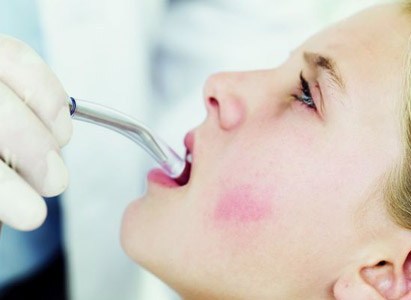The formation of oral cancer is a chronic pathological process: it may take several years, even decades to develop into typical or obvious cancer lesions. Therefore, regular oral check can timely and effectively prevent the occurrence of oral cancer.

1. Imaging examinations
(1) Radioactive nuclide inspection can provide information related to bone metastases of tongue thyroid or oral cancer.
(2) B-ultrasound.
(3) X-ray plain film and fault photography can provide more valuable information if oral cancer has invaded maxillary bone, mandible or accessory nasal paranasal sinus.
(4) CT inspection can observe tumor size, scope and surrounding tissues and the relationship with carotid artery, so that help to understand whether there is neck lymph node metastasis.
2. Cytological examination and biopsy
Exfoliative cytological is suitable for asymptomatic precancerous lesions or early squamous carcinoma that has not clear lesion range, and also suitable for screening inspection, and after that biopsy can be further performed to confirm the positive or suspicious cases.
Diagnosis of oral squamous carcinoma is usually conducted through pliers-taken or chipped biopsy. Because of its surface mucous membrane have been run broken or not normal, and also in superficial position; it should avoid the dead keratinized tissue, and also take samples in the boundary area between the tumor and surrounding normal tissue to guarantee that the sample has both tumor tissue and normal tissue.
Although the above biopsy rarely discovers tumor cell proliferation and metastasis, however, for some cases whose treatments have been delayed too long, local tumor growth acceleration can be found, so the interval between biopsy and clinical treatment shall be as short as possible. Besides, biopsy should be performed in the hospital that is capable of giving effective treatments.
3. Self-check
(1) Face and neck examination: when examining the neck, try to raise your head backwards as much as you can and check whether there are abnormalities in the inferior maxilla area and neck. Touch both sides of your neck and the inferior maxilla area with your hands to feel the difference between the inferior maxilla area and the two sides of the neck.
(2) Lip examination: observe the outer side of both lips, touch them with your hands, lightly pull down the lower lip with your fingers and check its inner side, and then check the inner side of your upper lip.
(3) Gum examination: observe your gums and touch them with your fingers to see whether there are abnormalities.
(4) Cheek examination: keep you mouth closed, lightly pull both corners of your mouth oppositely towards the direction of your ears, touch both your cheeks and see whether there is abnormality.
(5) Check your tongue: stretch out your tongue, hold it with your hand, touch and observe the surface, pull it to the left and then right side to check whether there are abnormalities on lateral borders.
(6) Check the roof of the tongue: raise your tongue, touch and observe it to check whether there are abnormities.
(7) Check the pharynx and palate: open your mouth and say “ah”, observe the pharynx under light, raise your head backwards, and touch the palate to see whether there is abnormality.
Modern Cancer Hospital Guangzhou remind that periodical oral check can contribute to early detection of disease; if early treatment is given, the treatment effects will be greatly enhanced.
 viber
viber